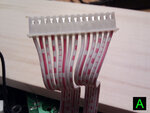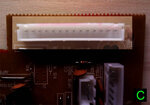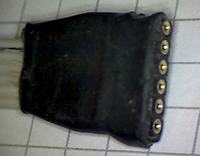wanamaker
Newbie level 5
- Joined
- Mar 28, 2011
- Messages
- 10
- Helped
- 0
- Reputation
- 0
- Reaction score
- 0
- Trophy points
- 1,281
- Location
- Minneapolis - MN
- Activity points
- 1,371
Hi there. Quick history: I pulled the housing off of a couple of MIDI keyboards that are specifically designed to hook up to a personal computer, MIDI to USB. (I basically created my own housing so they'd fit my space better.)
Having said that, I ran into a problem - the circuit boards need to be positioned in an area that are too far for some wires to reach. Here's what they look like (see below):
A. Side view:

B. Top view:

C. The area on the board the wire / cable plugs into (highlighted for clarity):

There's actually two questions:
1) What is this wire called? It's terrible that I ask a question about something I don't know the name of.
2) Since it cannot reach (to where I'd like it to go in relation to the keyboard), is there such a thing as an extension cord for this? That is, a male / female cord that I could extend this connection with?
Thanks for reading, any help would be appreciated!
Having said that, I ran into a problem - the circuit boards need to be positioned in an area that are too far for some wires to reach. Here's what they look like (see below):
A. Side view:

B. Top view:

C. The area on the board the wire / cable plugs into (highlighted for clarity):

There's actually two questions:
1) What is this wire called? It's terrible that I ask a question about something I don't know the name of.
2) Since it cannot reach (to where I'd like it to go in relation to the keyboard), is there such a thing as an extension cord for this? That is, a male / female cord that I could extend this connection with?
Thanks for reading, any help would be appreciated!
